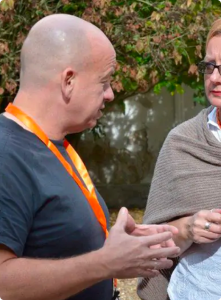Further BBN expansion in Japan: Symphony Marketing
The agency serves more than 600 client companies, including leaders in network management solutions, wired and wireless LAN access infrastructure, data storage, PCs, and servers.
Services and Specialities:
- Account-Based Marketing (ABM)
- Demand Generation
- B2B Marketing training & education
- Call centre services
We welcome their key principals President & Founder Ichiro Niwayama, COO Naoko Maruyama, and their team to BBN. Ichiro Niwayama has authored seven books on B2B marketing. His most recent book is currently a finalist for the Japan Marketing Academy’s Marketing Book Awards 2024.
“The Science of Profit Making’
Publication Date: March 15, 2024
Focus: This book draws from his 40 years of practical experience in B2B marketing and is the first book in Japan to address “Marketing Orchestration.” It provides a practical approach for individuals in marketing, sales, and manufacturing departments, as well as team leaders and executive management, discussing the mechanisms by which marketing may not contribute to orders and offering solutions.
BBN AI Studio is a joint endeavour inside the BBN world and is dedicated to empowering our partners with AI expertise, infrastructure, and products. Early partners have already experienced significant benefits, including enhanced team engagement with AI and improved market positioning through innovative AI solutions.
What’s in it for you?
- BBN AI Academy: Enhance your AI skills with customised masterclasses and exclusive access to our online platform, featuring on-demand AI content with different role- and seniority-tracks. This will help you save countless hours on internal training and research.
- BBN AI Space: Develop your AI projects using our comprehensive All-in-One Platform. It features essential models and powerful agent functionality, reducing the need for multiple licenses, specialised tools, and management costs.
- BBN AI Solution: Access pre-built AI products ready for client deployment, supported by our well-documented context knowledge. This approach minimises development costs, reduces the risk of failure, and accelerates time to market.
Why partner with BBN AI Studio?
- Tailored for BBN: Our dedicated BBN team ensures seamless integration with your business processes and AI roadmap.
- Scalable and Customised: Benefit from our proven, scalable academy and platform solutions and personalised service from our accessible and pragmatic team.
- Effortless Onboarding: Contact Carl to learn how BBN AI Studio can drive your success and elevate your AI capabilities.
Join us in this exciting journey to revolutionise your AI landscape with BBN AI Studio.
Contact Carl Derks for more information.
BBN’s partner agency Referro to lead launch campaign and future marketing strategy
BBN International won the business following a pitch led by long-time Dutch partner, Referro. C-Job is an independent ship design and engineering company that operates worldwide, with a global team of dedicated engineers and R&D consultants. Its cutting-edge work is dedicated to delivering sustainable maritime performance and support the building of more efficient, compliant and sustainable ships that will drive the maritime industry towards its net zero goals within a generation.
BBN offers international clients a unique, one-agency experience by drawing on an extensive and diverse pool of talent of partners based in 71 locations in 31 countries. Each agency retains its independent status, but through BBN can pitch for and work collaboratively with other B2B Partners on larger domestic, regional and global B2B briefs.

“We are one of the frontrunners in the field of innovation and technology. We have ambitious plans for the business and our future positioning which wouldn’t be possible without an innovative, creative approach to our sales and marketing. We can’t wait to work with BBN to showcase our progress and drive further brand growth.”
BBN will develop a new creative platform and positioning for C-Job as it strengthens its position in the US with additional marketing, with a focus on addressing a variety of stakeholder groups, including ship owners, shipbuilders and shipyards. As part of its remit, Referro has launched a new website for C-Job.
The work will be managed by marketing agency Referro as lead agency, with strategic support by research-backed insight partner Business Brainz, digital support from Stoica, digital relationship management by partner Centric, and their platform LiProspect, as well as additional assistance from Hungarian partner Contentplus. A launch campaign will be unveiled early in 2025, followed by paid media, sponsorships and a variety of events to follow.
As a company built on firsts and design breakthroughs, C-Job was the only firm to work on three of the world’s six dedicated new generation offshore-wind installation vessels. It has also completed pioneering work on the first ammonia-powered vessel refit including project planning and oversight (Amogy) and the first liquid hydrogen tanker concept powered by its own cargo (LH2 Europe).

“We’re hugely excited to work with C-Job Naval Architects to expand their presence. They have a forward- thinking culture and a bold ambition of making the shipping industry sustainable within one generation. We’re looking forward to helping them achieve this while pushing creative boundaries.”
Quake is a B2B agency based in Toronto, renowned for delivering strategic and creative solutions that drive results. Their deep experience in integrated campaigns, digital strategy, and brand development makes them a brilliant addition to our collective expertise. They bring with them a solid understanding of the Canadian market and a strong client portfolio across technology, manufacturing, and professional services.
They are enthusiastic about joining BBN and contributing to our collaborative culture – and they’re already exploring ways to support and engage with fellow partners.
In collaboration with Eye-Able® Benelux, the club’s website is being made accessible to everyone, regardless of their abilities. This initiative underscores PSV’s commitment to inclusivity in Dutch football.
With the implementation of Eye-Able Assist and Eye-Able Audit, PSV is creating a more user-friendly online environment. Eye-Able Assist offers tools such as adjustable contrast, a magnifier, and text-to-speech functionality, allowing users to tailor the website to their individual needs. Eye-Able Audit provides a thorough analysis of the site to identify and address accessibility issues based on WCAG guidelines.
“This collaboration is a wonderful step toward greater inclusivity in Dutch football,” says Jörgen van der Meulen, Technical Lead Engineer PSV at PSV. He emphasizes the importance of accessibility for all fans and expresses his gratitude to the PSV team, Menno Hoekstra from Eye-Able, and Carl Derks from Referro for the excellent cooperation.
With this initiative, PSV sets an example not only within football but beyond. Fans—regardless of their abilities—can now enjoy a truly accessible digital experience. A new milestone for inclusivity and innovation in the world of sports!
This is where the future of B2B marketing is being forged, and it’s happening now. Don’t get left behind. Be part of the revolution – because the future is happening.
Simultaneously in London and Chicago November 20th 2024
Referro | BBN The Netherlands is a supporting partner of B2B Worldfest 2024 – the intercontinental B2B event of the year. Our owner Gerard van den Bogaart will be attending the event in London. Give him a heads-up if you want to meet.
For more information on WorldFest, visit: https://events.thedrum.com/b2bworldfest/
For a discounted ticket to either the London or Chicago events, use code Referro10
A sneak peek into the challenges, innovations, and opportunities driving the future of B2B marketing.
Cameron shares his insights on what makes for a strong CMO-CRO relationship, how relationship marketing is changing, and the unique opportunities sports marketing presents for B2B brands. Whether you’re attending WorldFest or tuning in from afar, this conversation offers a sneak peek into the challenges, innovations, and opportunities driving the future of B2B marketing. Get ready for practical insights and forward-thinking strategies from one of the industry’s most seasoned observers.
For info on WorldFest, visit: https://events.thedrum.com/b2bworldfest/
For a discounted ticket to either the London or Chicago events, use code Referro10
Carl: Thank you both for joining us today. To start, Oliver, can you tell us how Eye-Able® began?
Oliver Greiner: Eye-Able® was founded by four friends who shared a vision for more inclusion and digital participation. We started developing our technology eight years ago and have been evolving it ever since. In the early years, we didn’t have any income; we were focused entirely on development. Our mission from the start has been to fight for greater digital accessibility for everyone.
Carl: There’s often a misunderstanding about who faces digital accessibility issues. What are your thoughts on that, Oliver?
Oliver Greiner: It’s true, there’s a lot of misconception. The reality is that 1 in 4 people have a vision impairment, 1 in 5 have a hearing impairment, 1 in 7 have a cognitive or learning impairment, and 1 in 10 have a physical impairment. These numbers are significant, yet not widely known.
Carl: What has Eye-Able® achieved so far?
Oliver Greiner: In Germany, we’re already helping thousands of users with our tools, and we’ve expanded to many parts of the world. Our next step is to introduce Eye-Able® to the Netherlands. We believe the Netherlands, with its serious approach to the ESG and WCAG Acts, is an ideal next market for us. The ESG Act promotes sustainability and ethical practices, while the WCAG focuses on web accessibility. Eye-Able® is right at the intersection of these important frameworks.
Carl: Menno, what are organizations in the Netherlands doing right now for digital participation and accessibility?
Menno Hoekstra: Currently, most organizations conduct manual audits of their websites to become WCAG-compliant. While these audits can help improve websites, they’re costly and not sustainable solutions. Eye-Able® offers continuous auditing of new content and a digital assistant, providing a more effective and long-term solution for digital accessibility.
Read about upcoming legislation
The EAA Act is coming! What do you need to know?
Did you know that about 21% of the Dutch population has a disability and may struggle with interpreting information on websites? Or that they might not be able to find the right information via search engines? In this blog, we show how to ensure that…Carl: Oliver, was law and compliance the focus when you started Eye-Able®?
Oliver Greiner: No, there was no specific law when we started. Our focus has always been on the people – 15% of the population is currently excluded, and we want to change that. We aim to give everyone an easy digital experience.
Carl: What advice would you give to web developers regarding your tools?
Oliver Greiner: Many web developers use free tools, but they often don’t use them correctly. They focus a lot on user experience, but they need to consider that 15% of users aren’t getting any experience at all without proper accessibility measures. Embracing our tools can lead to happier clients. And by integrating accessibility into their workflow, they add a significant group of users to their target audience.
Carl: What drives you to keep improving digital accessibility solutions, Oliver?
Oliver Greiner: For me, it’s all about the individual. We aim to build technologies that bridge the gap between barriers and access. There’s still a lot to develop, and we want to be the single solution provider that addresses all web accessibility issues.
Carl: Is creating a community important to you?
Oliver Greiner: Absolutely. Changing perceptions about people with disabilities is crucial. In Germany, we have team members with disabilities who provide invaluable insights and feedback. It’s also about understanding the market and using the right language. By integrating Eye-Able® into websites, organizations show their commitment to inclusion, which can change internal cultures and promote a more inclusive society.
Carl: Menno, why did you decide to take on the challenge of becoming the country manager for the Netherlands?
Menno Hoekstra: I’ve spent most of my career in sales, and I was determined to work for a company committed to a sustainable society. Eye-Able’s mission to promote inclusivity and break down digital barriers resonated with me deeply.
Carl: Were there personal reasons that influenced your decision?
Menno Hoekstra: Yes, definitely. I have a close friend with only 10% vision, and I’ve seen firsthand the digital frustrations she faces daily. This personal connection gave me an extra reason to help spread the message of Eye-Able®. I’m proud to work for a company making such a meaningful impact. If this opportunity hadn’t come along, I likely would have found another way to contribute to making the world a better place.
Carl: Thank you both for sharing your insights and the inspiring journey of Eye-Able®. Your commitment to digital accessibility and inclusivity is making a significant impact on countless lives. Oliver, Menno, your dedication, and passion are truly commendable. We look forward to seeing Eye-Able’s continued growth and the positive changes it will bring to the digital world. We hope this conversation has shed light on the importance of digital accessibility and the incredible work being done to ensure everyone can fully participate in the digital age.
About our digital accessibility services
Did you know that 21% of Dutch people have some sort of disability? This means that a lot of people may struggle with interpreting information on websites or even finding the right information through search engines. This presents an opportunity not only to expand your reach but also to contribute to an inclusive digital world.
We want to be your partner in digital accessibility. We understand how important it is to make your website accessible to everyone. Not just because it’s legally required, but because it offers a better experience for your visitors and grows your customer base.
Explanation of the European Accessibility Act (EAA)
Next year, the European Accessibility Act (EAA) will formally come into effect. This is international legislation that regulates digital accessibility. As a result, ATMs, financial services, and e-commerce companies (websites and webshops) must be digitally accessible. There are exceptions: small businesses are exempt from certain obligations.
When will the law take effect?
The changes for the implementation of Directive (EU) 2019/882 are expected to come into force on June 28, 2025. Since September 2020, all government websites must be digitally accessible. From June 2021, this also applies to mobile apps of governments.
Why is it urgent?
As an entrepreneur, you ‘formally’ have until June 28 2025 to make your website or webshop digitally accessible. Our advice? Don’t wait too long. The fines are substantial and can go up to €100,000,- depending on the violation. Moreover, an accessible website can attract up to 15% more customers.
Research shows that about 3 million people in the Netherlands and Belgium live with a disability. And the number is growing. About 60,000 people suffer a stroke each year, often resulting in permanent physical, emotional, and cognitive impairments. 10% of the male population has some sort of color blindness and the increasing aging of the population strengthens the need for accessible digital environments.
Web Content Accessibility Guidelines (WCAG)
WCAG, or Web Content Accessibility Guidelines, are international recommendations and guidelines for digital accessibility. The goal is to make websites and digital content usable and accessible to people with various disabilities, such as visual, auditory, physical, and cognitive disabilities.
Important WCAG Principles are:
Perceivable:
Content must be presented in ways that can be perceived by everyone.
Operable:
The interface and navigation must be usable by everyone, including those who cannot use a mouse.
Understandable:
Information and the operation of the user interface must be clear and understandable.
Robust:
Content must be reliably interpreted by various user agents, including assistive technologies.
Examples of WCAG Guidelines
• Text Alternatives: Provide text descriptions for non-text content such as images and videos.
• Accessible Navigation: Ensure all interactive elements are accessible via the keyboard.
• Readable Content: Use simple language and ensure sufficient contrast between text and background.
• Compatibility: Ensure the website works with different browsers and assistive technologies.
Why is this also interesting for you?
Increase Reach:
More people visit your website, potentially leading to higher revenue.
Compliance:
Avoid fines by complying with the EAA.
Contribute to Inclusion:
Provide better digital accessibility for both employees and customers.
Save Costs:
Make your website accessible now to avoid higher costs later.
Higher SEO Ranking:
Accessible websites offer a better user experience and are rewarded by Google.
Competitive Advantage:
Companies that take accessibility seriously have an edge.
Customer Loyalty:
Satisfied customers are more likely to return.
The solution
We work with Eye-Able®, which offers solutions to improve the digital accessibility of websites and digital platforms. They do this through various services and tools that ensure your website meets international accessibility standards such as the WCAG (Web Content Accessibility Guidelines).
They offer tools like magnification options, color filters, screen reader support, and customizable text display. This includes an audit tool that detects accessibility issues and provides solutions based on the latest guidelines. Additionally, we offer translation options and a tool for simplified translation to make content more understandable.
We list them below:
Audit Program: Comprehensive analysis of your digital platforms.
Assist Program: Tools and support to make your website more accessible.
Translations: Professional translation services to make your content more accessible to a broader audience.
Simpler Language: Adaptation of complex texts into simpler language for better readability and accessibility.
By following the WCAG guidelines, developers and designers can create inclusive websites. This way, everyone, regardless of their disabilities, has access to the information and services offered online.
What the experts say
Interview: Pioneering Digital Accessibility with Eye-Able®
Oliver Greiner, one of the co-founders, was inspired to start his company by his best friend’s visual impairment. We asked him and Menno Hoekstra, the country manager for the Netherlands, to share their passion and vision with us. In the conversation they share insights regarding…Be ready to make your website accessible to everyone

Contact Carl for more information about the possibilities.
Get in touch
+31 (0)85 07 06 936Send a message
Leave a message for CarlFor seasoned email marketers and those who occasionally send out newsletters, it is essential to revisit what we take for granted. This helps maintain quality and make the most of each campaign. In this blog, I share practical tips and insights to elevate your newsletters and email campaigns.
Whether you are a specialist or someone responsible for briefing third parties, these tips may offer valuable advice. A significantly improved newsletter can lead to higher engagement and conversion. Let’s dive into practical tips and insights that can take your newsletters and email campaigns to the next level.
1. Segment your lists
Personalize your emails by segmenting your audience. Segment by demographics, Customer Lifetime Value, behavior, engagement, and preferences. This increases the relevance and engagement of the reader.
2. Visual consistency
Keep your header and footer consistent, even if you are not using a template. This strengthens your brand identity.
3. Mobile optimization
More than half of emails are opened on mobile devices. Ensure a responsive design that works well on both desktop and mobile.
4. One goal per email
Use the rule of one: one goal and one central idea per email. This ensures clarity and showcases your expertise. Be clear about the purpose of your email. Do you want to maintain contact, generate revenue, build loyalty, or something else? Tailor your message accordingly. The more goals, the more likely readers will disengage.
Examples of different goals:
– Maintaining contact with all your target groups
– Staying top of mind
– Scheduling appointments
– Generating more revenue
– Building loyalty
– Retention/increasing revenue with existing customers
– Asking existing customers for a testimonial
– Providing information
– After-sales
5. Keep It Simple
People are overwhelmed with information and emails every day, so: “KISS” or “Keep It Simple Stupid”! Keep it simple, be to the point, and make sure people can easily scan your emails. If you want to elaborate, you can always link to an article or landing page on your website.
6. Catchy subject lines
Your subject line is the first impression you make. Ensure a short, powerful, and personal subject line that sparks curiosity and creates urgency. Use A/B testing to find out what works best.
7. Snippets for extra information
Don’t forget the snippet! This short line of text next to your subject line offers an additional chance to persuade your recipients to open the email.
8. Include a view Link
Always add a view link so that the recipient can view the email in a browser. This is useful if the email does not load correctly.
9. Short texts
Large blocks of text are rarely read in full in an email; they belong on the landing page. Keep it short and concise, and link to the extended content on your website.
10. Introtexts with text Links
Use both buttons and text links in your intro text. Some people prefer clicking on text rather than buttons, so give them both options. A button is a somewhat stronger call-to-action, and not everyone likes that. In text links, you can link to the same page as the button but with slightly different wording to persuade someone to click.
11. Above the fold
Internet users spend 80% of their time reading content above the fold. Additionally, research by Nielsen Norman Group shows that we follow an “F” pattern when reading online content, including emails. Therefore, place your value proposition and CTA at the top to ensure your readers see the most important message.
12. Compelling images
Use compelling images with alt text so that your message is conveyed even if visual elements do not load. You can also use your images to convey mood, emotion, or style. Furthermore, use the direction people are looking in the image to draw more attention to a CTA or text. It also matters whether a figure is looking into the newsletter or out of it.
13. Psychology of persuasion
Apply Cialdini’s principles of influence. I mention them below, but there is much online about them, so I will not elaborate further here:
- Reciprocity
- Commitment & Consistency
- Social Proof
- Liking
- Authority
- Scarcity
- Unity
14. Automated campaigns
Automate your email campaigns to ensure consistency and save time. Think about welcome series, abandoned cart reminders, and birthday emails.
15. A/B Testing
Test different elements such as subject lines, content, CTA buttons, and send times. Analyze the results and optimize based on what works.
16. Interactive emails
Experiment with interactive emails like polls, quizzes, and animated GIFs to increase engagement. Make sure the GIFs are not too large, as this can slow down the email load time, especially for recipients with slow internet.
17. Always check for typos
Checking your newsletter for typos or having someone else check it is crucial for a professional appearance. An error-free text builds trust with your readers and increases the likelihood that your message will be taken seriously. Moreover, it shows that you pay attention to detail and prioritize quality. It may seem obvious, but I still see newsletters with typos.
18. Use benchmark data
Compare your results with industry benchmarks. This gives you insight into where you stand and where there is room for improvement. I usually check multiple benchmarks to get an accurate picture of my industry on both national and international levels. Here are a few examples of benchmarks:
- International benchmark 2023 of the DDMA
- Spotler 2024
- Hubspot
- DeployTeq
- Klaviyo
- Constant contact, former SharpSpring
- Mailer Lite
19. Engage Your Community
Subscribe to newsletters from marketing automation platforms and follow email marketing groups on LinkedIn for the latest trends and tips, such as:
- Litmus They specialize in optimizing every email to maximize your ROI, testing your email for spam, and seeing how your email appears on each platform.
- Email Geeks on LinkedIn.
- Specialists on LinkedIn in various fields from email deliverability, DMARC, technology to content specialists.
20. Measure, analyze, and optimize continuously
Use analytics tools to monitor open rates, click-through rates, conversion rates, and other key metrics. Optimize based on this data and make sure to share and explain this data internally to create engagement within your organization. This also ensures internal visibility as a department by doing this on a weekly or monthly basis.
21. Feedback and innovation
Finally, remain open to feedback and innovations in your field. Try new strategies and keep learning from your results. Email marketing is a continuous process of testing, learning, and optimizing. By applying these tips, you can improve your email campaigns and achieve better results. What are your favorite tips that haven’t been mentioned yet? Share them with me!
Contact Monique or Suzan if you want to know more about how our expertise can strengthen your email marketing.
Curious about a relevant case study?


